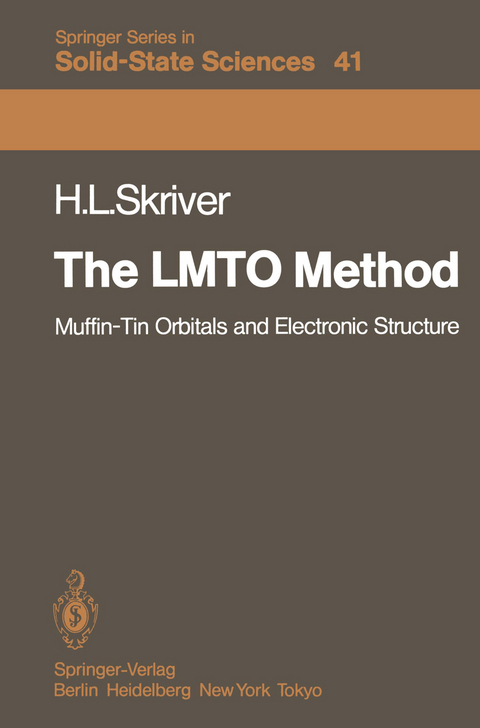
The LMTO Method
Springer Berlin (Verlag)
978-3-642-81846-2 (ISBN)
1. Introduction.- 1.1 The One-Electron Approximation.- 1.2 The Energy-Band Problem.- 1.3 Energy-Band Methods.- 1.4 Brief History of Linear Methods.- 1.5 Organisation of the Book.- 2. Canonical Band Theory.- 2.1 Muffin-Tin Orbitals and Tail Cancellation.- 2.2 Structure Constants and Canonical Bands.- 2.3 Potential Function and the Wigner-Seitz Rule.- 2.4 Potential Parameters, Unhybridised, and Hybridised Bands.- 2.5 Hybridised Canonical Theory.- 2.6 State Densities and Energy Scaling.- 3. One-Electron States in a Single Sphere.- 3.1 Radial Basis Functions.- 3.2 Partial Waves and Their Energy Derivatives.- 3.3 Logarithmic Derivative and Laurent Expansion.- 3.4 Potential Function and Bandwidth.- 3.5 Matrix Elements and Variational Estimate of Energies.- 4. Physically Significant Parameters.- 4.1 The Four Potential Parameters.- 4.2 How to Choose Ev?.- 4.3 Chromium 3d Bands: An Example.- 4.4 Free-Electron Potential Parameters.- 4.5 Volume Derivatives of Potential Parameters.- 4.6 Potential Parameter Relations.- 5. The Linear Method.- 5.1 Partial Waves for a Single Muffin-Tin.- 5.2 Muffin-Tin Orbitals.- 5.3 Expansion Theorem for MTO Tails.- 5.4 Energy-Independent Muffin-Tin Orbitals.- 5.5 One-Centre Expansion and Structure Constants.- 5.6 The LCMTO Secular Matrix.- 5.7 The LMTO Method.- 6. The Atomic-Sphere Approximation (ASA).- 6.1 The Kinetic Energy K2.- 6.2 An Error Estimate.- 6.3 The Atomic Sphere and the ASA.- 6.4 The Canonical Structure Constants.- 6.5 Muffin-Tin Orbitals in the ASA.- 6.6 Relation Between the LMTO and KKR Matrices.- 6.7 Wave Functions and ? Character.- 6.8 Projected State Density and Density of Electrons.- 6.9 The Combined Correction Term.- 7. Ground-State Properties.- 7.1 Cohesive Properties.- 7.2 Density-Functional Theory.- 7.3 Self-ConsistentBand-Structure Problem.- 7.4 Electronic Pressure Relation.- 7.5 First-Order Pressure Relation.- 7.6 Chromium: An Example.- 8. Many Atoms per Cell.- 8.1 Molecules and Clusters.- 8.2 The LMTO Formalism.- 8.3 Total Energy and Self-Consistent Energy Bands.- 9. Computer Programmes.- 9.1 The Self-Consistency Loop.- 9.2 Structure Constant Programme STR.- 9.3 Correction Structure Constant Programme COR.- 9.4 Linear Muffin-Tin Orbital Programme LMTO.- 9.5 Projected State-Density Programme DDNS.- 9.6 The Self-Consistency Programme SCFC.- 10. Self-Consistent Potential Parameters for 61 Metals.- 11. List of Symbols.- References.
| Erscheint lt. Verlag | 22.12.2011 |
|---|---|
| Reihe/Serie | Springer Series in Solid-State Sciences |
| Zusatzinfo | X, 286 p. |
| Verlagsort | Berlin |
| Sprache | englisch |
| Maße | 155 x 235 mm |
| Gewicht | 457 g |
| Themenwelt | Naturwissenschaften ► Physik / Astronomie ► Atom- / Kern- / Molekularphysik |
| Naturwissenschaften ► Physik / Astronomie ► Festkörperphysik | |
| Naturwissenschaften ► Physik / Astronomie ► Thermodynamik | |
| Schlagworte | band structure • band theory • electron • Elektronenstruktur • Energy • Experiment • LMTO-Methode • Structure |
| ISBN-10 | 3-642-81846-3 / 3642818463 |
| ISBN-13 | 978-3-642-81846-2 / 9783642818462 |
| Zustand | Neuware |
| Informationen gemäß Produktsicherheitsverordnung (GPSR) | |
| Haben Sie eine Frage zum Produkt? |
aus dem Bereich


